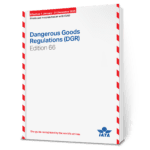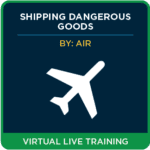
IATA 66th Edition Addendum Now Available
When it comes to regulatory compliance, “set it and forget it” just doesn’t apply. Just when you think you’ve got the latest edition figured out, changes can happen. That’s exactly the case with the 66th edition of the IATA Dangerous Goods Regulations (DGR), which has now been updated with a formal addendum—effective April 30th, 2025.
If you’re using an electronic copy, good news: these updates are integrated automatically. But if you rely on a printed version, it’s critical to download and print the addendum and place it at the front of your book. Even more important, read it carefully and make sure any relevant changes are communicated within your organization.
As you review the Addendum, you’ll notice the same symbols used in the DGR to indicate the type of change made:
Key Highlights of the 66th Edition Addendum:
- Sodium Ion Batteries: With these newly introduced entries, a large number of state and operator variations have been updated. Many airlines are catching up by adjusting packaging and handling instructions. Changes include:
- Updates to Packaging Instructions 952 and 966
- Addition of Special Provision A199 to the sodium ion battery entry
- Revisions to Table 9.1.A to reflect sodium ion batteries contained in equipment, and updates to button/coin cell entries
- New UN Numbers:
- UN 3423 – Tetramethylammonium hydroxide, solid
- UN 1835 – Tetramethylammonium hydroxide, solution
- Operator Limitations:
- Some airlines now prohibit transport of certain corrosive substances and explosives. Examples include European Cargo Limited (SE) and Sky Furth Regional Airlines (RV) has been removed all together.
- Battery State of Charge Clarification:
- The phrase “batteries at a state of charge not exceeding 30% of their rated capacity” has been removed. This signals a shift in how state of charge is to be interpreted or communicated.
- State Variations:
- Chile now requires Safety Data Sheets (SDS) for all international shipments entering the country.
- The previous requirement for SDS to be in Spanish has been removed.
- Update to appendix D.1 updates to contact information of competent authorities
Final Thoughts:
IATA updates its regulations periodically to correct errors, clarify existing rules, and introduce new requirements. This addendum is no exception. Even if the changes seem minor, they can significantly impact how you prepare and ship dangerous goods. Don’t wait until you’re caught off guard—download and review the addendum today using the official link in your preferred language.
Addendums for the IATA 2025 DGR, 66th Edition:
Download, print, and insert addendums into your publication. Digital publications are automatically updated.
English: IATA 2025 Dangerous Goods Regulations, 66th Edition – Addendum
French: IATA 2025 Dangerous Goods Regulations, 66th Edition – Addendum
Spanish: IATA 2025 Dangerous Goods Regulations, 66th Edition – Addendum
Contact our Regulatory Experts with questions about the IATA Addendum or Regulations—we’re here to help. Give us a call at 855.734.5469 or send us an email.
Stay up to date and sign up for our newsletter!
We have all the products, services and training you need to ensure your staff is properly trained and informed.
 IATA DGR IATA DGR |
 Shipping Dangerous Shipping DangerousGoods by Air Training |
 4GV Securepacc 4GV SecurepaccComplete Shipping Kit |






